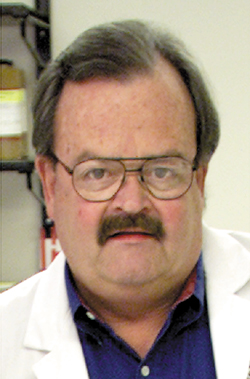
Roberts receives MERIT award after 10 years of study
Dr. L. Jackson Roberts II, professor of Pharmacology and Medicine, has received a coveted Method to Extend Research in Time (MERIT) award from the National Institutes of Health for his research on the role of free radicals and oxidative injury in human disease.
MERIT awards recognize and reward consistently high grant performance by providing up to 10 years of continuous funding without competitive review. “That’s a pretty big load off your mind, not having to spend time writing new grants,” Roberts said.
A decade’s worth of research led to Roberts’ MERIT award. In 1990, Roberts and colleagues discovered a novel group of compounds called isoprostanes. Isoprostanes are produced in the body when free radicals – highly reactive molecules derived from oxygen – attack the lipids that form cell membranes.
Discovery of isoprostanes made it possible for researchers to detect and monitor free radical reactions, something that hadn’t been possible before. “Measuring isoprostanes is absolutely the most reliable way to assess a free radical process in vivo,” Roberts said. “This has allowed us to define a fundamental role for free radicals in the pathogenesis of a remarkably diverse, large number of diseases.”
Isoprostanes have been used to implicate free radicals in atherosclerosis, neurodegenerative diseases, the normal aging process, and other diseases. The number of publications focused on isoprostanes “has increased exponentially,” Roberts said, from a single publication in the year of their discovery to nearly 250 last year.
Recently, Roberts and colleagues have discovered novel groups of free radical-produced compounds related to the isoprostanes. Among these new compounds are some of the most reactive molecules yet characterized, he said. They irreversibly bind to proteins in less than a minute, and cross-link them together like “molecular glue.”
Another set of newly discovered compounds, called isofurans, is a major focus of Roberts’ MERIT award research. Like isoprostanes, isofurans are produced by free radical reactions with membrane lipids. But whereas isoprostane formation decreases in the presence of high oxygen concentrations, isofuran formation increases dramatically under these conditions, Roberts said.
Roberts and colleagues speculate that isofurans may provide a window into hyperoxia-induced lung injury, a key problem faced in intensive care units. Patients on ventilators can only breathe oxygen concentrations up to 60 percent. Higher concentrations – though of certain benefit to the body’s organs – lead to lung damage. Investigators suspect that this damage is the result of free radical reactions, Roberts said, but isoprostane levels do not increase in an animal model of the lung damage. His group’s new studies will assess isofuran levels in hyperoxia-damaged lungs.
“If these isofuran compounds let us monitor the damage process, then they will provide a way to evaluate pharmacologic interventions that might prevent the damage and allow us to breathe patients with higher concentrations of oxygen,” Roberts said.
In addition to oxygen-induced tissue damage, Roberts and colleagues will explore the role of free radicals in aging.
The human body has elaborate systems for ridding itself of free radicals, Roberts said, and one popular theory for why we age holds that these processes become less and less efficient over time. The net effect is that “as we get older, we just oxidize ourselves to death,” he said. Just as rust marks the oxidation of iron, we may simply “rust” away as we age.
Extremely high isoprostane levels in aged rats support the oxidation theory of aging. Roberts and others believe that the process may be slow for a long period of time and then take off suddenly. This could account for the rapid decline in the function of multiple organs in elderly patients who enter the hospital with a disorder that exposes them to oxidant stress. If excessive oxidative damage accompanies this rapid decline, anti-oxidants might improve outcomes for these patients, Roberts said.
The most familiar anti-oxidants on the market are vitamins E and C. Though these vitamins do lower free radical reactions, as measured by isoprostane levels, they’re not very effective, Roberts said. Even super-high doses of the vitamins achieve only a 50 percent reduction of isoprostanes. “We need something better,” he said.
Other VUMC faculty members currently funded with MERIT awards are: Albert H. Beth, Ph.D., professor of Molecular Physiology & Biophysics; Alan D. Cherrington, Ph.D., Charles H. Best Professor of Diabetes Research, professor and chair of Molecular Physiology & Biophysics; Dr. Daryl K. Granner, Joe C. Davis Professor of Biomedical Science and director of the Vanderbilt Diabetes Center; Tadashi Inagami, Ph.D., Stanford Moore Professor of Biochemistry; David M. Lovinger, Ph.D., professor of Molecular Physiology & Biophysics; Elaine Sanders-Bush, Ph.D., professor of Pharmacology and Psychiatry; Conrad Wagner, Ph.D., professor of Biochemistry; and Michael R. Waterman, Ph.D., Natalie Overall Warren Professor of Biochemistry and chair of the department.













